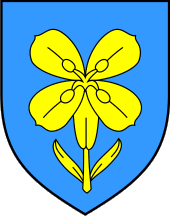Senj
Senj (pronounced [sɛ̂ːɲ]) (Italian: Segna, Latin: Senia, German: Zengg) is a town on the upper Adriatic coast in Croatia, in the foothills of the Mala Kapela and Velebit mountains.
Senj | |
|---|---|
| Grad Senj Town of Senj | |
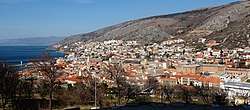 View from the Nehaj Fortress | |
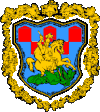 Seal | |
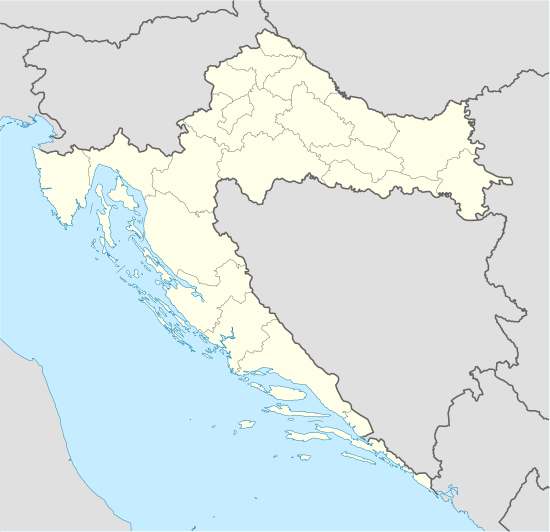 Senj Location of Senj within Croatia | |
| Coordinates: 44°59′24.52″N 14°54′10.96″E | |
| Country | |
| County | |
| Government | |
| • Mayor | Darko Nekić (HDZ) |
| • Town Council | 15 members
|
| Area | |
| • Town | 658 km2 (254 sq mi) |
| Elevation | 0 m (0 ft) |
| Population (2011)[1] | |
| • Town | 7,182 |
| • Urban | 4,810 |
| Time zone | UTC+1 (CET) |
| • Summer (DST) | UTC+2 (CEST) |
| Postal code | 53 270 |
| Area code(s) | 053 |
| Website | senj.hr |
The symbol of the town is the Nehaj Fortress (Croatian: Tvrđava Nehaj) which was completed in 1558. For a time this was the seat of the Uskoks (Italian: Uscocchi), who were Christian refugees from Ottoman Bosnia resettled here to protect the Habsburg borderlands. The Republic of Venice accused the Uskoks of piracy and declared war on them which led to their expulsion following a truce in 1617.
Senj is to be found in the Lika-Senj County of Croatia, the Roman Catholic Diocese of Gospić-Senj and the Roman Catholic Archdiocese of Rijeka.
History

Senj has apparently been inhabited since prehistoric times. A settlement called Athyinites in today's Senj was mentioned in Greek documents dated to 4th century BC. The Illyrian tribe Iapydes were settled around the town.
Senia was a thriving town in the Roman province of Dalmatia, used by the Romans as a stronghold against the Illyrians in the 2nd century BC. After the fall of the Roman Empire, the Avars and the Croats eventually settled here in the 7th century AD.
The Catholic diocese of Senj was established in 1169. King of Hungary Béla III gave the town to the Knights Templar in 1184, and in 1271 it became the property of the Frankopan counts of Krk.
In 1248 the bishop of Senj was allowed by Pope Innocent IV to use the Glagolitic alphabet and the vernacular in liturgy. A Glagolitic printing press was set up in 1494 and produced the incunabula The Glagolic Missal and Spovid općena.
The military captaincy of Senj was established in 1469 in order to defend against the invading Ottoman and Venetian armies. The town sheltered thousands of refugees from nearby occupied areas. The Nehaj Fortress was completed in 1558 on the hill Nehaj, which at the time was outside of town. Today it is wholly within the town's borders. The wars with the Ottomans lasted well into the 17th century. During this time the Uskoks lived in Senj and occupied the fortress. They served an important purpose during the wars since they had small units of men rowing swift boats that proved to be very effective guerrilla forces. However, after the Uskok War with Venice, which ended in 1617, they were forbidden to settle in the area. Prince Radic was appointed Prince of Senj by king Rudolf emperor of Austria (1 December 1600). (Radic family) Native noble family from Lika region; members of the family were Uskok military leaders at the headquarters in Senj.
The 18th century brought some prosperity, especially with the construction of the Josephina (named after Emperor Joseph II) linking the Adriatic coast via Senj to Karlovac. The railway line built in 1873 between Fiume (Rijeka) and Karlovac did not pass by Senj which held back further development.
Until 1918, the town was part of the Austrian monarchy (Kingdom of Croatia-Slavonia, Lika-Krbava County after the compromise of 1867), in the Croatian Military Frontier (Regiment III).[2][3]
In the fall of 1943, during World War II, when Fascist Italy capitulated, the Partisans took control of Senj and used it as a supply port. Subsequently, the Luftwaffe started bombarding the town. By the end of the year they had demolished over half of the buildings in town and inflicted heavy civilian casualties.[4]
Climate
Senj has a temperate climate which is usually described as temperate Oceanic or Marine west coast, with mild, windy winters and relatively dry and warm summers. According to the Köppen climate classification it falls within a cool, dry-summer subtropical zone (Csb), with cool-summer Mediterranean characteristics such as its usually dry summers.
| Climate data for Senj | |||||||||||||
|---|---|---|---|---|---|---|---|---|---|---|---|---|---|
| Month | Jan | Feb | Mar | Apr | May | Jun | Jul | Aug | Sep | Oct | Nov | Dec | Year |
| Record high °C (°F) | 20.3 (68.5) |
22.2 (72.0) |
25.9 (78.6) |
29.5 (85.1) |
33.6 (92.5) |
36.3 (97.3) |
39.7 (103.5) |
38.6 (101.5) |
35.6 (96.1) |
29.9 (85.8) |
26.9 (80.4) |
20.9 (69.6) |
39.7 (103.5) |
| Daily mean °C (°F) | 6.1 (43.0) |
6.6 (43.9) |
9.5 (49.1) |
13.3 (55.9) |
17.9 (64.2) |
21.9 (71.4) |
24.5 (76.1) |
24.2 (75.6) |
20.2 (68.4) |
15.6 (60.1) |
11.1 (52.0) |
7.5 (45.5) |
14.9 (58.8) |
| Record low °C (°F) | −11.8 (10.8) |
−16.6 (2.1) |
−9.3 (15.3) |
−0.8 (30.6) |
3.4 (38.1) |
7.6 (45.7) |
10.5 (50.9) |
8.2 (46.8) |
6.7 (44.1) |
1.6 (34.9) |
−4.9 (23.2) |
−10.4 (13.3) |
−16.6 (2.1) |
| Average precipitation mm (inches) | 94.2 (3.71) |
90.4 (3.56) |
86.7 (3.41) |
96.1 (3.78) |
91.7 (3.61) |
84.9 (3.34) |
64.5 (2.54) |
94.6 (3.72) |
137.9 (5.43) |
143.4 (5.65) |
165.3 (6.51) |
124.5 (4.90) |
1,274.2 (50.16) |
| Average rainy days | 10 | 9 | 10 | 12 | 11 | 10 | 8 | 8 | 9 | 10 | 13 | 12 | 122 |
| Average snowy days | 2 | 3 | 2 | 0 | 0 | 0 | 0 | 0 | 0 | 0 | 1 | 2 | 10 |
| Mean monthly sunshine hours | 100.9 | 123.2 | 158.1 | 187.7 | 242.7 | 265.8 | 310.2 | 287.2 | 214.7 | 167.6 | 101.8 | 90.2 | 2,250.1 |
| Source: Croatian Meteorological and Hydrological Service[5] | |||||||||||||
Economy
Modern Senj is a seaside tourist town. Primary industries are fishing, boating, and tourism.
Gallery
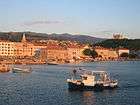 Senj waterfront
Senj waterfront Senj harbor chained with snow after a cold front
Senj harbor chained with snow after a cold front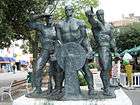 The Three Seamen statue
The Three Seamen statue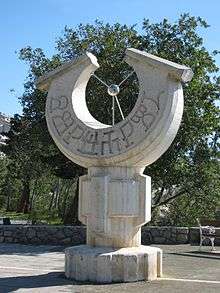 The Sundial in the town that lies on the north 45th parallel
The Sundial in the town that lies on the north 45th parallel- View on Adriatic Sea
- The fortress Nehaj is the most famous monument and symbol of Senj
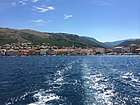 A view of Senj from the sea. Taken summer 2015
A view of Senj from the sea. Taken summer 2015
Population
The settlement of Senj itself has 4,810 inhabitants, while the whole administrative area of Town of Senj has 7,182 inhabitants.
Population by nationality:
There are 27 settlements in the Town of Senj and they include: Alan, Biljevine, Bunica, Crni Kal, Jablanac, Klada, Krasno, Krivi Put, Lukovo, Melnice, Mrzli Dol, Pijavica, Podbilo, Prizna, Senj, Senjska Draga, Starigrad, Stinica, Stolac, Sveta Jelena, Sveti Juraj, Velike Brisnice, Veljun Primorski, Volarice, Vrataruša, Vratnik i Vrzići.
Notable people
International relations
References
- "Croatian Census 2011". Croatian Bureau of Statistics. Retrieved July 5, 2013.
- Perhaps Regiment II. The map shows Zengg at the borderline between II and III.
- Handbook of Austria and Lombardy-Venetia Cancellations on the Postage Stamp Issues 1850–1864, by Edwin MUELLER, 1961.
- Mihael Sobolevski (December 1, 2003). "Bombardiranje Senja zrakoplovima u Drugom svjetskom ratu". The Review of Senj (in Croatian). City Museum Senj – Senj Museum Society. ISSN 0582-673X.
- "Mjesečne vrijednosti za Senj u razdoblju1948−2014" (in Croatian). Croatian Meteorological and Hydrological Service. Retrieved December 3, 2015.
External links
| Wikimedia Commons has media related to Senj. |
